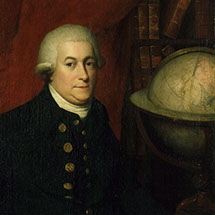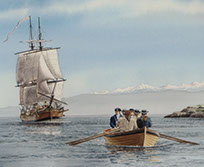 Captain George VancouverNo one knows the name of the first woman or man to take the first “walking tour” of this area, but we do know that the ancestors of today’s Native Americans were present in North America at least 12,000 years ago. There is written evidence of Europeans exploring the coast much later, particularly in the 18th century as Russian traders came down from Siberia and Spanish navigators came up from the south, drawing their maps and making their claims. The most significant of the European explorers was George Vancouver, whose British expedition in the 1790s mapped 5,000 miles of the North American coast so well that portions of his maps were still used in the 1920s. The official Naturalist for the expedition, Archibald Menzies, did his own “walking tour” of this area, on the morning of May 31st, 1792. From the report of Mr. Menzies:
Captain George VancouverNo one knows the name of the first woman or man to take the first “walking tour” of this area, but we do know that the ancestors of today’s Native Americans were present in North America at least 12,000 years ago. There is written evidence of Europeans exploring the coast much later, particularly in the 18th century as Russian traders came down from Siberia and Spanish navigators came up from the south, drawing their maps and making their claims. The most significant of the European explorers was George Vancouver, whose British expedition in the 1790s mapped 5,000 miles of the North American coast so well that portions of his maps were still used in the 1920s. The official Naturalist for the expedition, Archibald Menzies, did his own “walking tour” of this area, on the morning of May 31st, 1792. From the report of Mr. Menzies:
“The forenoon of the thirty first I had a stroll on shore on the point—Mr. Broughton nam’d the point from the vast abundance of wild roses that grew upon it Rose Point… The land everywhere around us was still of moderate height covered with a thick forest of different kinds of Pine trees. In a marshy situation behind the Beach I found some aquatic plants I had not before met.”
In addition to dramatically increasing Europe’s knowledge of the western coastline of North America, the Vancouver expedition checked the advances of both Spain and Russia in the New World. Some speculate that if Captain Vancouver had chosen to explore and survey the Columbia River, as was done by the American Captain, Robert Gray, then the territory north of the river, including Washington State, would be part of Canada today. Captain Vancouver named or approved the naming of (as in the case of Rose Point above) such nearby features as Whidbey Island and Possession Sound (toward the west) and Gardner Bay (toward the north in front of Everett). Mt. Rainier, Mt. Baker, and Puget Sound are also among the other four hundred or so place-names left in the wake of the Vancouver voyage. In 1841, the American expedition of Charles Wilkes renamed our walking tour area Point Elliott, but Vancouver’s legacy lives on in Mukilteo in the former Rosehill School, now replaced by the Rosehill Community Center.
 The ChathamAfter Vancouver’s visit, fur traders began exploring and filtering into the region by land, bringing with them new trade goods which were incorporated into the daily activities of the Native Americans. The Euro-American newcomers also brought with them diseases like smallpox and measles, which decimated the Indian population. It was reported that in some villages, nearly two-thirds of the people perished. In the 1850s, American settlers began to pour into the Puget Sound region, enticed by a law that offered 320 acres to each settler, and a second 320 for his wife if he had one. The settlers soon began calling for treaties to enable them to secure legal title to the land. On January 22, 1855, some 82 Indian leaders, including four commanding figures--Patkanim, Seattle, Goliah, and Chowitshoot--concluded their treaty negotiations here in Mukilteo with the Washington Territorial Governor, Isaac Stevens.
The ChathamAfter Vancouver’s visit, fur traders began exploring and filtering into the region by land, bringing with them new trade goods which were incorporated into the daily activities of the Native Americans. The Euro-American newcomers also brought with them diseases like smallpox and measles, which decimated the Indian population. It was reported that in some villages, nearly two-thirds of the people perished. In the 1850s, American settlers began to pour into the Puget Sound region, enticed by a law that offered 320 acres to each settler, and a second 320 for his wife if he had one. The settlers soon began calling for treaties to enable them to secure legal title to the land. On January 22, 1855, some 82 Indian leaders, including four commanding figures--Patkanim, Seattle, Goliah, and Chowitshoot--concluded their treaty negotiations here in Mukilteo with the Washington Territorial Governor, Isaac Stevens.
Considerable confusion and distrust resulted from the Point Elliott Treaty, and the other nine treaties signed at about the same time throughout the Territory of Washington. Here in Mukilteo, negotiations were translated through several languages and conducted primarily in the “Chinook jargon,” a trade language that contained approximately 300 words. Since the Lushootseed people organized themselves by town, instead of by tribe with a designated political leader, some communities were left out of the process entirely. Wracked by disease, suffering from settler attacks, and desperate for the assistance promised by the federal government, the four major Indian representatives and the 78 others signed the treaty. But it is certain that none understood all its provisions, nor could anyone foresee the long-term consequences of their actions in Mukilteo on that cold day in January, 1855.
Copyright 2015, Mukilteo Walking Tour. All rights reserved.